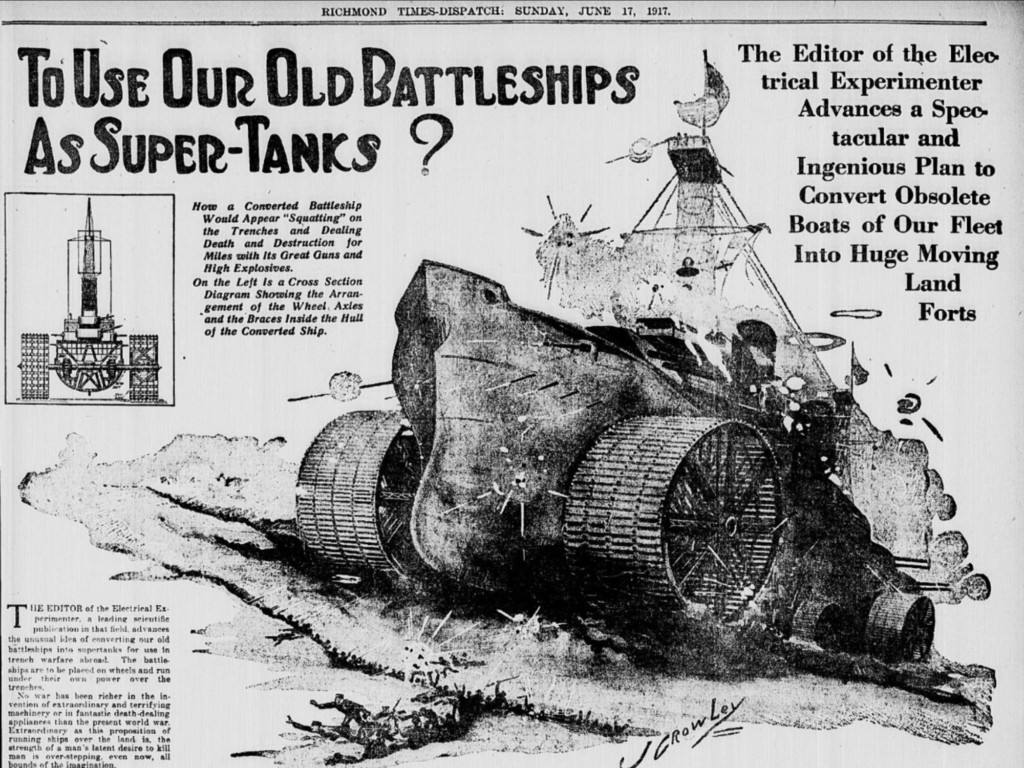
Popular Science article, 1917. As USA entered the war and lacked everything including tanks, PopSci published an article about the idea of… putting old pre-dreadnoughts on tracks (or wheels in this case).
We must remember that the idea was not that outlandish back in 1917. After all, the only significant fiction about the matter has been HG Wells famous “land ironclads” that our friends at Tanks Encyclopedia already treated in HG Wells Fictional Tank and the famous German ww2 “Land Kreuzer” designed by an U-Boat officer.
The relations between the navy and first tanks is going a long way and particularly strong during WW1. In the UK, Winston Churchill was first lord of the admiralty, but after he was demoted after the disaster at Gallipoli and served for some time on the western front, came back through the “land battleship committee” with tank projects that were essentially driven by the navy, including by the use of barbettes (Mark I and successors) and light naval guns. Both allies were looking forward naval fleets and classifications to find an equivalent on land, from the “cruiser tanks” to the massive breakthrough tanks assimilated to battleships. The French FCM were for example built in a naval yard.

American landship: The CBL 75, with its remarkably “boat-like” hull and specific turret. Both homegrown vehicles served from 1917 as bond risers, and were seen on the Fourth of July celebration in San Francisco in 1917, training later with 5th Infantry, California guard Regiment. These were mock-up armored vehicles with little military value.
As for putting pre-dreadnoughts on wheels, and see them run in the no-man’s land it’s downwards absolute fantasy. A standard pre-dreadnought displacement was about 16,000 tons, and the VTE steam engines were fed by 12 Babcock and Wilcox boilers for a total of 16,500 hp. so about 18 knots at best. This was a power-to-weight ratio of just one horsepower per ton. Let’s remember that the heaviest German Tank of WW2, the self-propelled gun Jagdtiger own ratio was 9.8 hp per ton and yet its V-12 Maybach HL 230 P30 making 700 PS allowed it to reach a top speed 34 km/h (21 mph), meaning around 10 kph cross-country. Reduced to the same ratio as the “wheeled battleship” (for example the Virginia class), this would have been at best 1.2 to 1.8 kph. Needless to say the power generated by these VTE in terms of torque, and without a transmission would never had been enough to make the whole “vehicle” move at all, in any circumstances. Needless to say also nuclear power was not around in 1917.
HG Wells “land ironclads” novel

Visionary author HG Wells envisioned giant machines for war, just as Jules Vernes, pessimistic about the relations between industry, capitalism and nationalism, that would erupt indeed in two world wars. Giant machines always has been a fascination, and due to the naval power of Great Britain, it was not that far fetched to imagine equivalent on land, especially from the Empire which led the world through its naval industry.
Wells “land ironclads” novel, published in 1903’s Strand Magazine were essentially a new way for nations to settle their differences on the battlefield with a near-absent infantry but massive, 100-foot-long (30 m) armoured fighting vehicles, using Bramah Diplock’s pedrail wheels, and remotelly operated or robotic rifles. The novel was well read in the civilian and military circles alike, as a projection of near-future form of warfare. Influence was such that the initial through of an armored vehicle able to cross the no-man’s land was through pedrail, before the track system, which was relatively similar, imposed itself. The name “ironclad” referred to the old-fashioned depiction of steam-powered capital ships since the 1860s. But it was more appropriate than “battleships”, implying something like a ship transferred on land. The trend was well alive after WW1, generating more works of fiction such as M. Moorcock 1971 steampunk novel the “Land Leviathan”, and many others.

Holt gas-electric tank. There was also a steam tank prototype, developed by the Stanley Motor Carriage Company in Watertown, Massachusetts in 1917. Contrary to France or Great Britain, no American naval yard could undertake the construction of tanks. The only company that was ever committed in the war effort was Ford. Holt will also design a steam-propelled wheeled landship, and a 150 tons multi-turreted steam wheeled “land monitor” in 1917. None were built.
But it had also a tremendous influence over the early applicators of what was essentially an industrial, attritional land warfare. Infantry was soon abundantly reported as an easy prey for machine-guns, as well as artillery shrapnells. For both, the only cure was armor, preferably in motion, to cross the no-man’s land. The latter, especially on the western front, was nothing more than a desolate soaky mud wasteland, devoid of any construction or vegetation. It recalled the sea to some extent, and forbade the use of any wheeled armored vehicles, which existed before 1914. In the United Kingdom, the most spectacular crossover between ground motorized warfare and naval thinking was the Landship Committee.
The “naval gang”: 1915 Landship committee
Also called the Director of Naval Construction’s Committee, this small British committee was formed in 1915 to develop armoured fighting vehicles in order to unlock the Western Front. By February 1915 its most active and influential supporter was the First Lord of the Admiralty Winston Churchill. The entire staff was made of naval officers, with a few politicians and engineers. Eustace Tennyson d’Eyncourt, Director of Naval Construction at the Admiralty was heading it. There were reasons for this.
Early Mark I Tanks manufactured at the Vickers armstrong factory.
Notably Vickers-Armstrong, the world’s largest military manufacturer and already procuring both the fleet and army their hardware, was the only logical way to manufacture tanks due to the total absence of suitable option on the civilian market, facilities and resources. Such machines using thick armor imposed this and explained the path chosen by the British army for their standard tank, a heavy rhomboidal model heavily influenced by naval concepts.
Another reason was the staff itself, recruited by a prominent naval officer, and backed by the first lord of the admiralty. Army officers at the same time has been perhaps considered too conservative in their approach of warfare, whereas the Navy embodied state-of-the art technologies of the time, first to adopt aviation, ballistic computers, heavy automation onboard, complex armour systems and advanced foundry techniques. Aviation was developing quicker, but this technology was not advanced or credible enough to solve the problem of trench warfare.
Third, and more importantly, the committee’s activities were concealed from Kitchener, the War Office, the Treasury, or the Board of the Admiralty itself, as it was though they would block it. This secret activity later gave the “gang” its popularity, when returning to activity in the interwar on projects such as the TOG heavy tank (see later).
The staff comprised also Flight Commander Thomas Hetherington of the Royal Naval Air Service (RNAS) at the head of the Armoured Car Squadron based in Dunkirk, the only British armoured unit of the time, with significant experience. No tanks here, just improvized armoured Rolls-Royce cars used to pick-up pilots stranded behind quickly evolving enemy lines. Also was present Colonel Wilfred Dumble of the Naval Brigade, under Colonel R.E.B. Crompton, to develop cross-country vehicles for the Army. Hetherington at first directly proposed a 300 tons wheeled landship. For him, maverick American-born inventor Robert MacFie proposed a first landship in 1915 and another, even larger in 1916. But other figures soon rose to prominence such as William Tritton and Ernest Swinton.

Crushing barb wire has been generating lots of interest for giant crusher wheels at a time tracks were still not a proven concept. The Russians developed a prototype, known as the Lebedenko or “Tsar Tank”, which never made it to the battlefield due to its unsurprisingly low weight-to-power ratio. Note the conning tower/turrets arrangement. The Russians certaonly not shy of such projects. In 1911 already, Mendeleev’s Super Heavy Tank was proposed, an armoured heavy artillery carrier, armed with an amazing 120 mm Canet gun (51 shells). This was battleship standard. In 1918, the Italian would even make an “iron horse”, heavy autonomous artillery carrier capable of operating a 12-in guns, the largest self propelled gun of that era.
The topic is too vast to go in depth over its developments, but it was essentially responsible for many projects, all influenced by the “land ironclad” trope, and to the standard British heavy tanks, which was given barbette guns instead of turrets, known since well before the war on armoured cars, because of stability concerns. Armament was standard Vickers QF guns, 6-Pdr types (57 mm), soon discarded as its long barrel cause issues in the mud, and replaced later by a long, then a short Hotchkiss QF 6 pdr (57 mm), found more appropriate, and also for supply reasons, alongside Hotchkiss MGs on “female” versions. Although there was never any comparison between a “battleship” and the Mark I to XII models that were built or conceived in just two years, there were definitive references over a “cruiser” concept with the Mark A “Whippet”.
This nimbler tank was designed a bit as a cavalry tank, to exploit any breakthrough and caused havoc in enemy rear lines as well as providing reconnaissance (by the means of pigeons). The concept of “Cruiser” was strong enough to be kept as such during the whole interwar, and until the very last designed cruiser tank of WW2, the Centurion, which was undergoing tests in September 1945, production starting in November. This became the world’s first “main battle tank”, the idea of a “universal tank” taking care of both the heavy and medium tank roles. The tradition was kept alive through the letter “C” adopted for each tank’s name until now and the Challenger 2, standing of course for “Cruiser”.
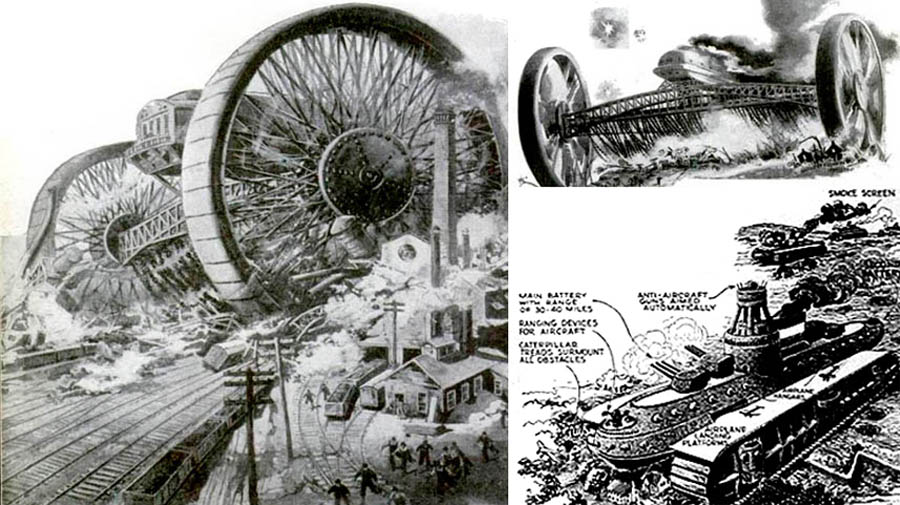
As the US were not even committed to the war, Popular Science Magazine came out with inflammatory, sensationalist ideas and concepts, such as this December 1916 edition showing a wheeled “land destroyer”. This was Shuman’s superdreadnought
In France, a hardy supporter and proponent of the tank idea was Estienne, but the driving force behind was not the Navy but the Artillery corps. Conflict with the top brass and interarms dispute meant tank development took time, but naval comparisons took traction as well in France. The Schneider CA-1 was essentially a boat-like “mud-surfer”, whereas Estienne in 1916 devised at the same time a small “mosquito” tank roughly comparable to a torpedo boat to “overwhelm the enemy”, and instead of the Navy he was the first to contact a car manufacturer in order to deliver the required production, which was considerable. For his “heavy breakthrough model”, he contacted a naval yard, for the same reason Vickers worked on many British tanks: The facilities, skills and manpower to make the heavy armour plates and structure.
This was the FCM (acronym of the yard) F1, a 70 tonnes behemoth with two turrets and modern tracks plus airship engines. But the complexity of the vehicle and other reasons let the project drag on until the German capitulation and the ten made only emerged in 1922. FCM would produce another model for the French Army, a 1936 light tank designed to replace the Renault FT. Other French Yards made proposals, but none was approved. If the war has dragged on for one or two more years, no doubt that many tanks in construction or in plans at that time would have been worthy of the title of “land battleships”; such as the German 120 tonnes Großkampfwagen (K-Wagen) or the British Flying Elephant.
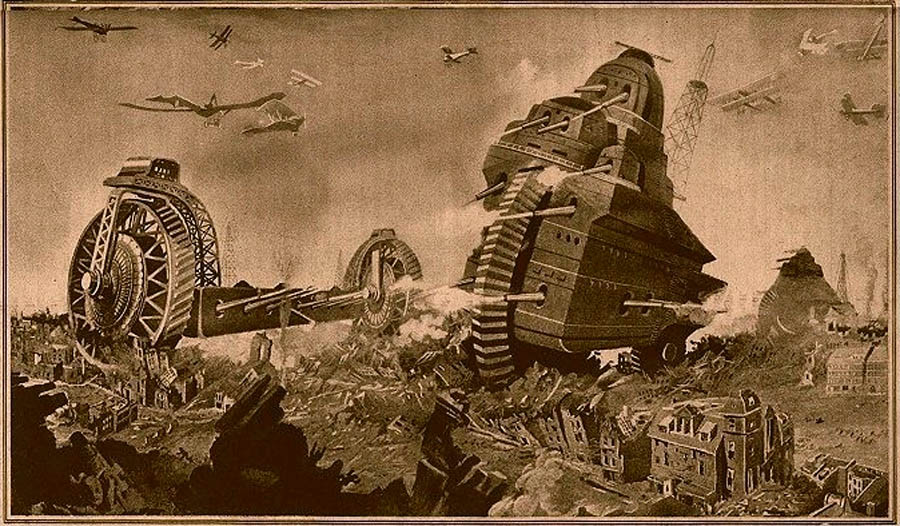
Landship Terror, on the German side: Die Wochenschau “future land ships”, october 1916, showing a battle between a gigantic trench destroyer and a powerful electrically-driven “circle cruiser”. These publications further fuelled the nightmarish vision of future conflicts in an inhumane, highly industrial setting, which also participated in the strong wave of pacifism which followed the war.
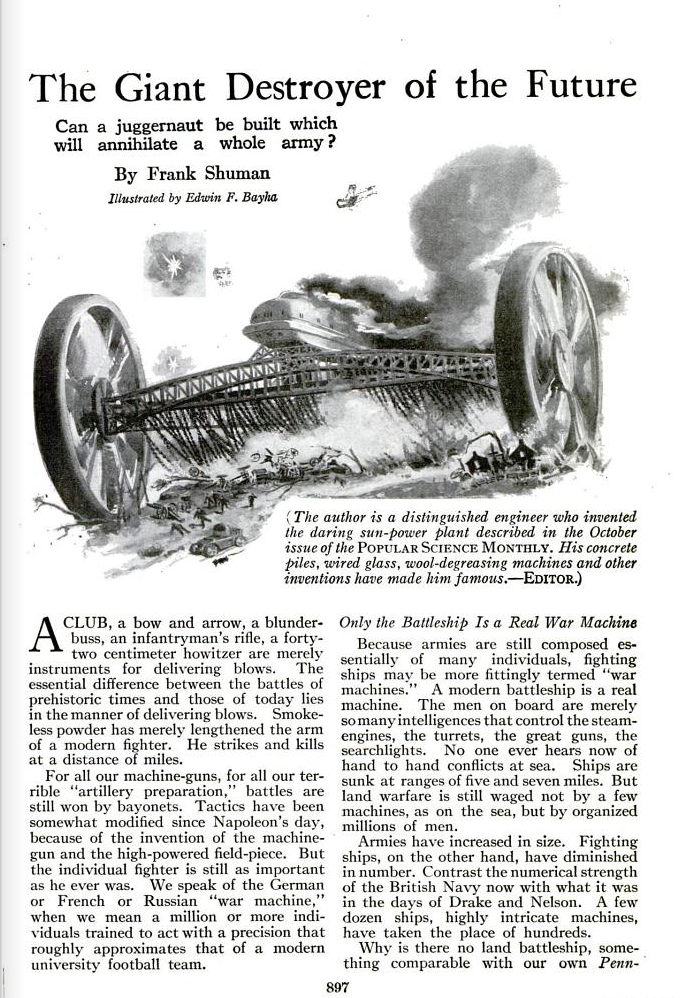
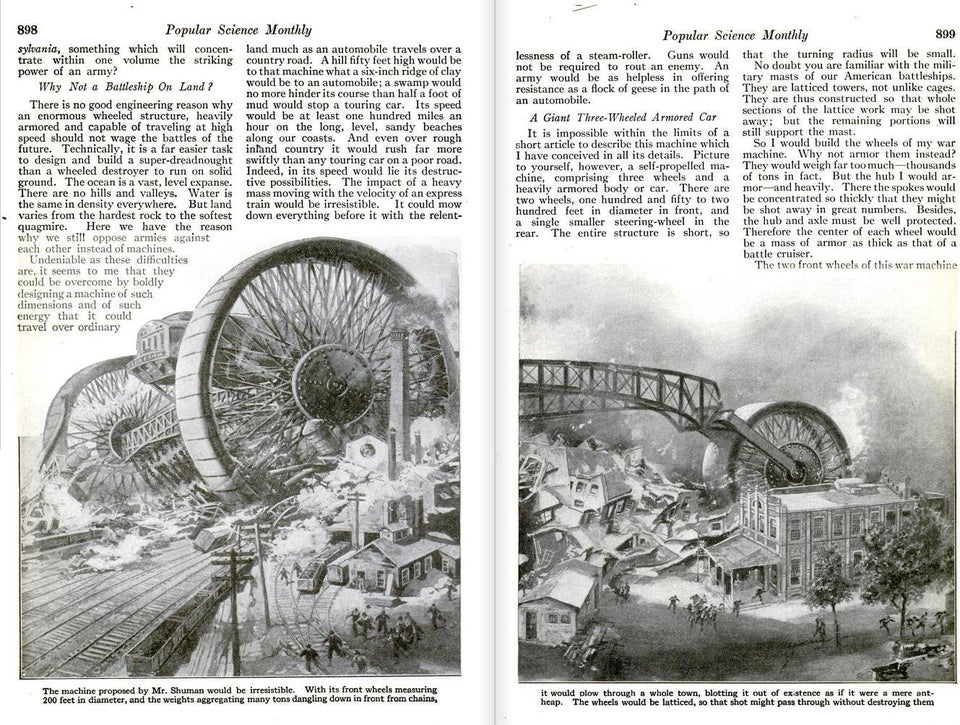
An article of October 1916 over an imaginary “giant land destroyer”, in PopSci by Frank Schuman “only a battleship is a real war machine”.
Interwar: The fad of ‘land cruisers’
Some could have guess that this relations were about to end after the war, since the Tank was now well installed into the military structures, opening a whole new dimension of thinking, tests and exercises. But the “navy” influence over interwar tank design was not done yet, far from it. The most distinctive feature inspired by warships and tried on Tanks until WW2 was indeed the multi-turreted configuration. Now this seems odd to us, overcomplicated and inefficient, but at that time it made sense, even after the modern and “reasonable” FT tank which still did not earned the recognition of the military.
After all this model was called even by its thinker, the General Estienne, as a “mosquito tank”, the equivalent of a destroyer. The same had in mind a breakthrough tank, multi-turreted, to deal with the Hindenburg line and its fortification strongpoints.
British multi-turreted tanks

If the concept of multiple turrets on a tank seems to us ludicrous, let’s dive into the mindset in which they were generated. The pioneers in that matters were not British, but French, although multiple turrets designs were also worked out by the Germans in 1918. Already the FCM 2C was given two turrets, one forward and one at the “stern” and was manufactured from 1917 by a naval yard, at La Seyne, Forges & Chantiers de la Mediterranee (FCM).
The ten supertanks, the heaviest ever built until 1943’s German Königstiger heavy tanks, proved more useful as propaganda tools and were not even committed in action by 1940. Nevertheless it impressed greatly the “Old Gang” the original team behind the first British tank in 1915, to built the two interwar supertanks called the TOG-1 and 2, mere prototypes for trench warfare.
In between Vickers had its own way on the concept, presenting to the Army the A1E1 Independent, arguably the most influential multi-turreted tank design ever produced. The multiple turret solution was seemed as a way to cover more ground fire simultaneously as infantry was, in a trench warfare scenario, still the worst enemy for a tank.
Indeed the Achilles heel of the tank always has been overall vision. A tank with a single turret advancing forward was an easy prey for infantry armed with explosives of incendiaries sneaking from the sides and rear. More turrets meant more terrain covered. Smaller MG-armed turrets “covered” the main turret shelling fortifications.
This was a case where a single costly tank could operate almost on its own. The same concept was in any case popular with riverine monitors until the Vietnam war. Other multiple turrets designs were produced such as the Medium Mk.III, and some made it to the battlefield of WW2 such as the “cruiser” tanks such as the Mk.I, Mk.III and the Cruiser VI Crusader.
But soon it was discovered how much these turrets were an hinderance and they were deleted. The unique turret of most tanks in WW2 was given a coaxial MG, sometimes one on its bustle, one or two on the roof, added to the hull glacis ball MGs, covering nearly all angles, requiring thus a smaller, more manageable crew, sparing manpower.

The original TOG-1 from the same team as the “land battleship committee”, showing its turret and barbette guns.
Soviet multi-turreted tanks
The influence of British design over Soviet tank production was considerable. After copying the French Renault FT for its first tank, Soviet forced equipped themselves with the (early) multi-turreted T-26 derived from the Vickers 6-ton Mark E, but also developed two multi-turreted tanks, the medium T-28 (three turrets) and the giant T-35, with five, like the A1E1. These tanks never survived the mayhem of Operation Barbarossa and went out as curiosities. Speculation over Stalin’s wicked interest over “land cruisers” generated a speculative design called the KV-6, debunked since.

Largely inspired by the British A1E1, the six-turreted T-35 was perhaps the best embodiement of a “land cruiser” in 1930; Very costly, they performed poorly in combat and must be seen as propaganda tools more than effective fighting machines.
Japanese multi-turreted tanks
There were several prototypes, attempts to devise multi-turreted heavy tanks, the most ellusive one being the 100 tons O-I, the Type 91 and Type 91 heavy tanks. Like the Soviets, Japanese engineers rather favored ball-mounted rear turret bustle machine-guns to cover more angles.
German multi-turreted tanks

A pioneer in a sense by making the Sturmpanzerwagen Oberschlesien models in 1918, both having barbettes fore and aft embedded in the main compartment, Germany went to produce heavy tanks in the 1930s, tested in Kazan, Russia, in great secrecy. They figured out quickly that multi-turreted tanks were an approach fit for trench warfare, but in quick-mobile formations communicating well and comprising portee infantry for cover (Panzergrenadiers), this was not required. Therefore the only eleven ever made were the six prototypes built at Kazan (called Grosstraktor), and the five Neubaufahrzeug deployed in (limited) service in Norway in 1940.
German land cruisers

However this was a different story in 1942, when a naval officer came to visit Hitler, bringing with him with a project that was later given the name Landkreuzer P.1000 Ratte. It had all the trademarks of an authentic “land cruiser” project, starting from the very name “landkreuzer”. P.1000 stands for 1,000 tons. Nerds would have quickly remarked the Scharnhorst type turret also. The only difference was it was a twin-gun model. It went back to a strategic study by Krupp of Soviet heavy tanks designs, which later generated the Porsche “Maus” super-heavy tank, of which two prototypes were tested. The Kriegsmarine had been badly depleted and discredited in Norway and later with the loss of Bismarck, to the point Hitler disregarded the Navy completely, only conceding to his now adviser and soon C-in-C, admiral Dönitz.
However, Krupp’s director, Edward Grotte, a special officer for submarine construction proposed on 23 June 1942 to Adolf Hitler his “landkreuzer” project. Hitler, obsessed by his Wagnerian visions of grandeur, was quickly seduced with the project and ordered a study, which came back as OKH Auftrag Nr. 30404 and E-30404/1 in December. The incentive around the design was to “recycle” the surplus main gun turrets left over from the planned refitting of the Scharnhorst-class battleships. But as the project gained traction and the design was refined, it was found vital to protect the vehicle with an amazing 250 mm (9.8 in) armour plates plus several anti-aircraft guns mounts (Flakvierling) against allied attacks in 1943. Hitler gave it the greenlight, naming it the “Rat”, but the concept soon ran into critics, like Guderian declaring: “Hitler’s fantasies sometimes shift into the gigantic”. It was however cancelled by Minister of Armaments Albert Speer in early 1943, seeing there a titanic waste of resources Germany could ill-afford at this critical point.
The idea of such tank, confirmed by very little documentation, is still debated by historians today. It would have featured not only the 750 tonnes turrets and the five-storey structure that depended on it, reduced and simplified (as the ammo tunnel does not have to be lower than a single level), separate magazines, shell rooms, handling machinery for the ammunition. To gain weight, the turrets were reduced to twin configuration instead of the original triple, and the armament was completed by a 128 mm anti-tank gun of the type used in the Jagdtiger or Maus in a rear hull turret, two 15 mm Mauser MG 151/15 autocannons in side sponsons and eight or sixteen 20 mm Flak 38 AA guns. Other accommodations would have comprised a vehicle bay to hold two BMW R12 motorcycles for scouting, storage rooms, compact infirmary area and self-contained lavatory system.
To move its 1000 tonnes as projected on paper, the Landkreuzer would have needed no less than two U-Boat MAN V12Z32/44 24-cylinder marine diesel engines of 6,300 kW (8,400 hp) each (with snorkel for river crossing) or eight E-Boat Mercedes engines. To pass this power to the ground, the land cruiser needed to rest on six 1.2-metre (3 ft 11 in) wide and 21-metre (69 ft) long treads, making two giant composite treads, distributing the weight. Needless to say, the vehicle needed to be steered of firm ground, excluding roads and bridges, crossing rivers by itself. Gargantuan consumption compared to U-Boats would have limited its estimated range to just ~190 kilometres (120 mi) at a top speed of ~40 km/h (25 mph), reduced to 10-15 in “cruising” mode in rough terrain.

The Maus was the only German “super-heavy tank” of the war, but stayed at prototype stage. Albeit “only” two hundred tons, its behaviour only precluded the future use of the Ratte.
Historians had pointed out since many issues with the design:
-Starting with the very size of the tank itself, which limited both its speed and range, and made it a very tempting target for allied aviation.
-Of course the cost, manpower and resource required were beyond any reasonable prospect by 1943.
-But most of all, the “Ratte” did not fit any tactical Wehrmacht requirement. The idea of a giant tank in itself was tempting, as this model’s armament and protection made it invulnerable to anything deployed on the battlefield, including the best allied antitank guns. Only another ship could have dealt with it from a coastal area. But there was a vague idea of its use as a mobile command and support vehicle for a Panzerdivision. For this however, there was no room for extra command features, powerful radio sets and a command bridge; As a pure self-propelled gun, the Landkreuzer had indeed the best firepower of any German armored vehicle of that time, but in 1943 Germany was already on the defensive, so the need for mobile heavy artillery was declining, especially of this caliber which condemned it to deal with fortifications (likely Soviet).
Against other tanks, the massive 28 cm guns would have needed long delays to reload, and although the 28 cm SK C/34 naval gun was the same version, using armor-piercing ammo in alternative, the rate of fire was not enough to assure an efficient cover. At best, the Ratte was a mobile fortification for which no doctrine has been developed, and those dating back from trench warfare were of no use in WW2. Another project was also unveiled after the war which stayed at simple proposal stage, without even a sketch to back it up, the self-propelled P.1500 “Monster”. It was essentially a “Dora” supergun placed on a similar chassis instead of its original railroad system.

Puckridge’s Land Battleship, Australia, 1944
The concept of land battleships today
A Still feasible concept
Due to the very same same reasons the concept never made it through, notably the laws of gravity and power required to move very large objects on land, the idea is still impracticable, but not technically. So in short, yes, a “land warship” could be made today. However, warfare development that already makes near-obsolete the main battle tank would certainly doom any such project, for few advantages, if any.
Cold War giant amphibious vehicles

Arguably far away from ships, these are rather vehicles made to either float or move submerged at a reasonable depth (around five meters max after preparation). In 1918 the British created the first amphibious tank, called the Mark X Duck, based on the IX “Pig” APC, and Vickers produced a couple of light amphibious models that met some export success in the interwar. However the amphibian concept only got traction in WW2. Soviet Russia was probably in 1941 the greatest user of the type, with several thousands in use, well helped by the lack of roads, muck and marshes of the Pripet area and some tactics. The allies had their fair share of amphibious vehicles thanks to US Industry, like the standard “truck” called the DUKW, the atrocious SEEP, or many heavy LVT landing crafts of the serie launched by the Alligator in Louisiana. By the end of the war, this experience was considerable, and the Cold War saw a continuation of dedicated amphibious tanks as well as amphibious capabilities generalized to all AFVs, either floating or going submerged through rivers.
Perhaps the largest of all these serial military amphibious vehicles was the LARC-60 or LARC-X was truly a behemoth of a vehicle, probably one of the largest vehicles ever made, capable of carrying 200 troops and all sorts of tanks and armored vehicles, including other amphibians. The 100-tons monster had each wheel propelled by a single GMC 250 hp diesel engine, and the whole vehicle was made by Letourneau from 1952. These saw service notably during the Vietnam war and stayed in service, amazingly enough, until 2001. Could this vehicle be assimilated to a “land ship” ? Certainly yes, given the fact it was basically a large landing craft on wheels. Could it be converted as a properly military version ? Given the fact it can carry a tank or artillery pieces with room enough to operate them from its interior, yes.
However no very large dedicated amphibian fighting vehicle was developed as a transitional ship/land vehicle, at least due to size constraints. Does a tracked vehicle could have been larger ? Nothing is clear about it. There are no records of a larger amphibious vehicle or project. Crawler-Crusher – illustration by Andrei ‘Octo10’ Kirushkin
A modern “nuclear land missile destroyer” (NLMD)
Modern technologies had shown that any moving object can be fitted with the most powerful source of energy available: Nuclear Power. If the latter was largely adopted on ships and submarines, it was above all because of gravity and weight constraints. But there is virtually no technical limitation into taking the whole electronics suite of a missile destroyer, stripped of ASW capabilities, sonar, and antiship weaponry, ect. fitted on a superstrong, super-heavy duty chassis, and propelled by a single or two nuclear reactors. Giant vehicles were produced until recent years for very specific tasks, which would certainly “fit the bill” as carriers, with a point in common, an abysmally low speed however.
It should be noticed that nuclear power was experimented on tanks in 1950, on the Chrysler TV-8. The shielding weight in that case was not an hindrance. The TV-8 only weighted 25 tons, and the turret bustle was used to house a Chrysler V-8 engine composed of a Gas turbine engine drive, using a Hydrocarbon-based vapour-cycle power plant and a Nuclear-powered vapour-cycle power plant. The turret buoyancy was used to allow the tank to float, making it an early amphibious model. Extrapolating from this, its not hard to see a possible larger “heavy tank”, but the fad quickly died as the main battle tank filled that role. However the Astron “X-weapon” project did not presented any significant advantage over conventional designs and the study was not pushed forward, terminated in 1956, only sketches and a model remaining.
A recognisable -yet less glamorous- engineering feat of the Apollo Program was this 2 700 tonnes behemoth, called the ‘Crawler’. Able to carry the 3000 tons of the rocket and 1500 tons of its support, the NASA crawler could have been lifting about 4,500 tons of useful weight, on a surface of 40×35 m so about 1600 m2. Any kind of military hardware and controls, radars could fit in, without a doubt. For better useful surface, spread over both prototypes, built in 1965 by Bucyrus International and Marion Power Shovel Company at 14 millions dollars apiece. This would produce a 90 m long utility platform, to install all the hardware equivalent to a missile destroyer. But before seeing this done, there are several extremely limiting factors that makes that idea ludicrous at best:
-Special roads are needed to support its weight (NASA’s “Crawlerways” for example), and needless to say the whole road network and bridges could not support it.
-Speed is painfully low, at 1.6 kph or just 1 mph, making the produced vehicle a near-immobile target.
-Consumption is gargantuan, with 19,000 liters (5,000 U.S. gal) of diesel fuel, burning 296 liters per kilometer for barely over 7 km.
-Larger speeds would require perhaps twice the power of a supercarrier, as ground friction as way above marine friction and the forces implicated in cross-country at higher speeds are just beyond any material resistance but using specially engineered Carbon-fiber reinforced tinanium, raising the cost even more. However there are other “ready made” chassis on the market:
-4250-W “Big Muskie” chassis
Supporting the weight of its dragline coal excavator crane, the Ohio-based “Big Muskie” spanned 148 meters long, for 27,000,000 pounds (12,000 t; 14,000 short tons). This machine could have supported a platform with many equipments, but top speed was limited to asthmatic 0.1 mph or 0.16 km/h, for a power supply reaching 18.04 megawatts, and supplied at that via a trailing cable (13,800 volts). Needless to say, both autonomy and the energy supply made it impractical, but fitting it with nuclear energy.
Overburden Conveyor Bridge F60
The Muskie was still small in comparison to the 500-meters long, 13,800 tonnes Overburden Conveyor Bridge F60, a German-built 1969 vehicle made to exploit the brown coal (lignite) opencast mining in the Lusatian coalfields in Germany. With her size and articulated wheeltrain, this could have made a nice (but light) support for weapons systems and sensors, however, again, it relied on externally powered electricity, for a total of 27 MW (35,000 hp), therefore nuclear power was again the only option, for a top speed of 0.8 kph at best in its original configuration.
The smaller (220 m, 13,500 tons) Bagger 288 remains the largest Bucket-wheel Excavator ever built, its articulated excavating wheel alone being around 15 meters in diameter. Like the other four manufactured, including the 1995 Bagger 293, these vehicles required external supply 16.56 megawatts, whereas the entire structure rested on some twelve caterpillar tracks located on two articulated bases. Let’s not missed there there are “mobile structures”, not fit for large distances in speed. Any military applications would need a completely new dedicated platform, potentially reusing very little of these concepts.
The case of hovercrafts
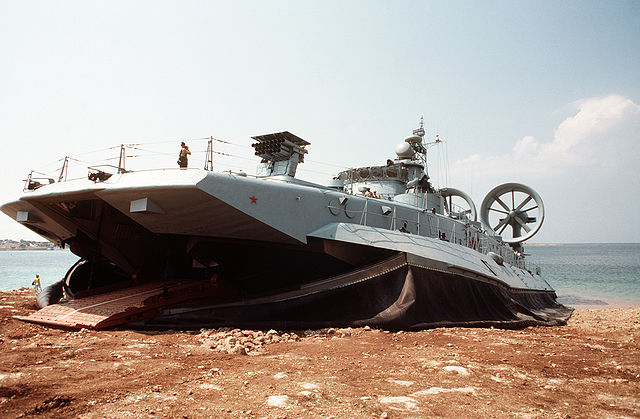
If the technology went back to the early XXth century and is different from the “wing-in-ground effect” already overviewed on the Ekranoplane, the technology needed first to better contain the air (hence the invention of the flexible skirt) and next, to be steerable. Both conditions were filled in the 1960s when both the military and civilian market operated many of these singular crafts, at ease mid-way between the sea and land, but using aircraft tech. These perfect amphibians were a seducing proposition and found their way into the Soviet, American and British Navies, which pushed the envelope as far as they could. Nowadays, the largest military hovercraft ever built belongs to the Chinese, derived from the Russian 550+ tonnes Zubr class. But they are used as landing crafts. To be used as fighting crafts of their own, they would need certainly to grow in size.
Currently the two main limitation over the use of giant hovercrafts are:
-Massive consumption (which provoked the retirement of civilian ones after the 1970s oil crisis)
-Short range (which is linked to the weight and consumption).
-Limited payload and no protection
There are severe constraints as to built a larger hovercraft, over 1,000 tonnes. The first being the increase of power needed to lift such weight, further limiting speed and range. Nuclear power could be a solution, although hitting the same wall as for nuclear bombers developed in the late 50′ to the 60′: The heavy shielding to protect the crew really stuck these planes to the ground. They were barely able to fly, let alone to carry any loads. Some suggested with the development of drones, a giant nuclear-powered hovercraft could be remotelly controlled, but the severity of the nuclear radiations would have been ‘frying’ many of the electronics over time, not counting the hazard in maintaining these crafts. In addition, would you trust AI enough to operate complex systems such as a remote-controlled cruiser or missile destroyer ?
Conclusion: Technically feasible, but…
In the end, with this concept of “land cruiser/destroyer/battleship”, we are left with the realm of engineering/military phantasms and fantasy. Technical limitations are many that just dictates how much weight can be applied to a vehicle. They dictates each time a formidable amount of power to procure enough speed on all terrains. Such mass imposes to carefully plan any move, even involving geology study. A target of that magnitude can throw away any prospect of stealth. But overall, since WW2, and later time and again, the cold war proved warfare was mobile and inter-arms, with aviation playing an essential role. Mobile fortresses has no use in such environment.

Australian Cossor land cruiser (1943)
Added to this, such an extremely heavy vehicle still does not fit any military requirement, at least until now. On the contrary, water covers 4/5 of the planet, compounded by satellite-guided long range cruise missile which could reach any point on the planet, and therefore traditional warships are just perfect for their intended role. No military staff would seriously consider any though of having much costier, less mobile and more vulnerable land equivalents. With miniaturization, modern MBTs are increasingly more efficient and versatile, just as modern nuclear submarines are.
At 70+ tonnes they are already heavier than many fast attack crafts around the world and there is certainly no urge to make them larger, quite the contrary, as now lighter wheeled vehicles are preferred for mostly asymetric warfare operations. Like battleships in the past, main battle tanks are now considered less and less useful, and traditional tank makers have no plans for replacement, but only upgrades of their existing systems, dating back from the cold war.
Land battleships however has there been since HG Wells and Robida, a seducing concept. They will stay an eternal feature in fiction, such as Jackson’s “mortal engines”‘s mobile cities, or those spectacular of “Carter of Mars” and perhaps the more realistic land task forces of the video game Homeworld: Desert of Kharak. Bigger is only better… on paper, and warships needs to stay in their element, the only they are made for.
Read More:
//en.wikipedia.org/wiki/The_Land_Ironclads
//en.wikipedia.org/wiki/Landship_Committee
teoti.com/military/115791-strangest-tanks-in-history-part-1.html
//www.historynet.com/hitlers-monster-tanks.htm

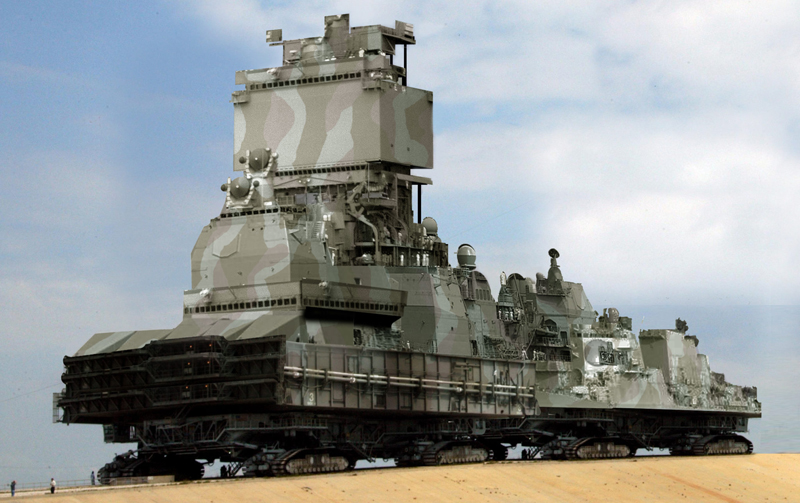
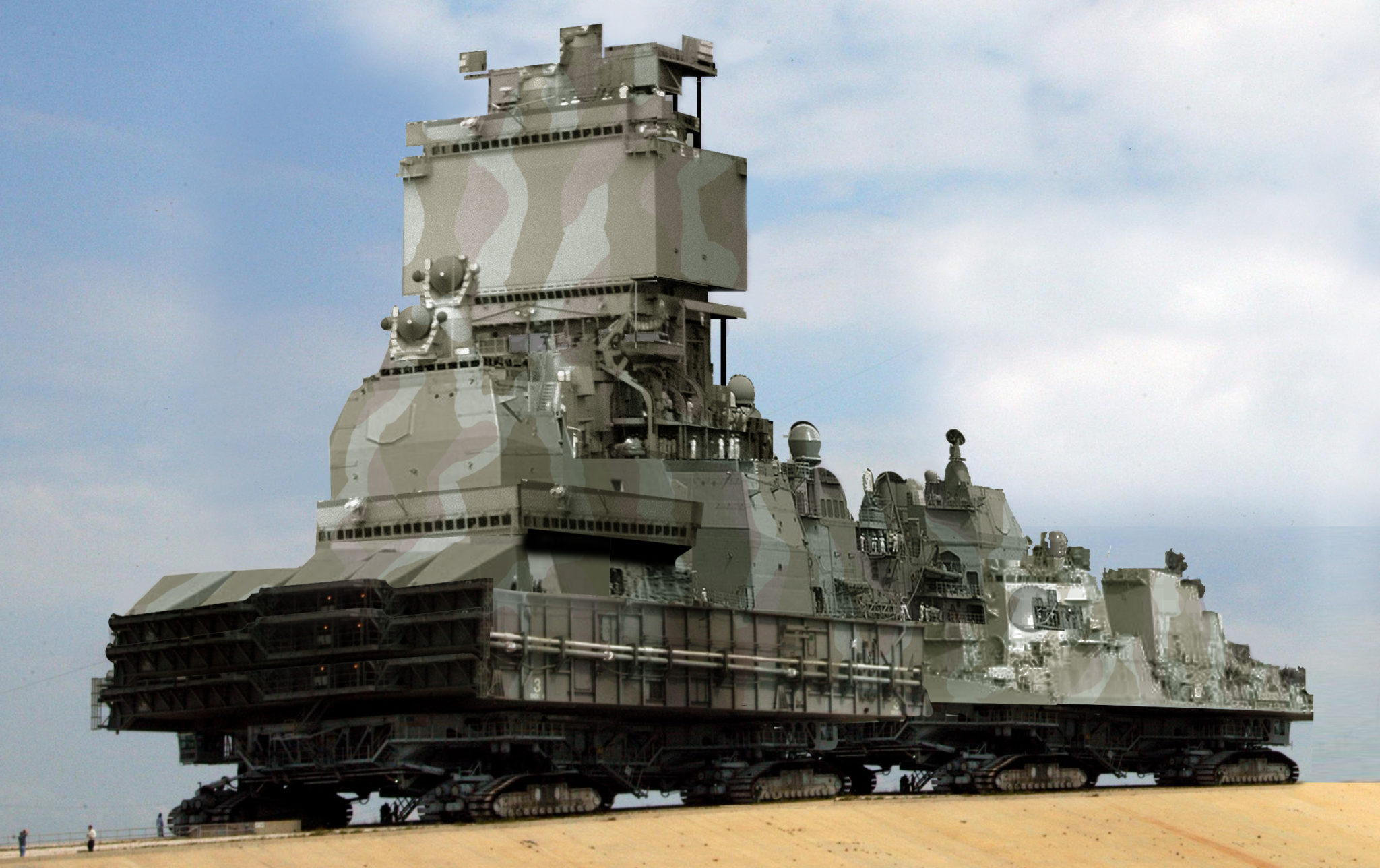
 Latest Facebook Entry -
Latest Facebook Entry -  X(Tweeter) Naval Encyclopedia's deck archive
X(Tweeter) Naval Encyclopedia's deck archive Instagram (@navalencyc)
Instagram (@navalencyc)





 French Navy
French Navy Royal Navy
Royal Navy Russian Navy
Russian Navy Armada Espanola
Armada Espanola Austrian Navy
Austrian Navy K.u.K. Kriegsmarine
K.u.K. Kriegsmarine Dansk Marine
Dansk Marine Nautiko Hellenon
Nautiko Hellenon Koninklije Marine 1870
Koninklije Marine 1870 Marinha do Brasil
Marinha do Brasil Osmanlı Donanması
Osmanlı Donanması Marina Do Peru
Marina Do Peru Marinha do Portugal
Marinha do Portugal Regia Marina 1870
Regia Marina 1870 Nihhon Kaigun 1870
Nihhon Kaigun 1870 Preußische Marine 1870
Preußische Marine 1870 Russkiy Flot 1870
Russkiy Flot 1870 Svenska marinen
Svenska marinen Søværnet
Søværnet Union Navy
Union Navy Confederate Navy
Confederate Navy Armada de Argentina
Armada de Argentina Imperial Chinese Navy
Imperial Chinese Navy Marinha do Portugal
Marinha do Portugal Mexico
Mexico Kaiserliche Marine
Kaiserliche Marine 1898 US Navy
1898 US Navy Sovietskiy Flot
Sovietskiy Flot Royal Canadian Navy
Royal Canadian Navy Royal Australian Navy
Royal Australian Navy RNZN Fleet
RNZN Fleet Chinese Navy 1937
Chinese Navy 1937 Kriegsmarine
Kriegsmarine Chilean Navy
Chilean Navy Danish Navy
Danish Navy Finnish Navy
Finnish Navy Hellenic Navy
Hellenic Navy Polish Navy
Polish Navy Romanian Navy
Romanian Navy Turkish Navy
Turkish Navy Royal Yugoslav Navy
Royal Yugoslav Navy Royal Thai Navy
Royal Thai Navy Minor Navies
Minor Navies Albania
Albania Austria
Austria Belgium
Belgium Columbia
Columbia Costa Rica
Costa Rica Cuba
Cuba Czechoslovakia
Czechoslovakia Dominican Republic
Dominican Republic Haiti
Haiti Hungary
Hungary Honduras
Honduras Estonia
Estonia Iceland
Iceland Eire
Eire Equador
Equador Iran
Iran Iraq
Iraq Latvia
Latvia Liberia
Liberia Lithuania
Lithuania Mandchukuo
Mandchukuo Morocco
Morocco Nicaragua
Nicaragua Persia
Persia San Salvador
San Salvador Sarawak
Sarawak Uruguay
Uruguay Venezuela
Venezuela Zanzibar
Zanzibar Warsaw Pact Navies
Warsaw Pact Navies Bulgaria
Bulgaria Hungary
Hungary

 Bundesmarine
Bundesmarine Dutch Navy
Dutch Navy Hellenic Navy
Hellenic Navy Marina Militare
Marina Militare Yugoslav Navy
Yugoslav Navy Chinese Navy
Chinese Navy Indian Navy
Indian Navy Indonesian Navy
Indonesian Navy JMSDF
JMSDF North Korean Navy
North Korean Navy Pakistani Navy
Pakistani Navy Philippines Navy
Philippines Navy ROKN
ROKN Rep. of Singapore Navy
Rep. of Singapore Navy Taiwanese Navy
Taiwanese Navy IDF Navy
IDF Navy Saudi Navy
Saudi Navy Royal New Zealand Navy
Royal New Zealand Navy Egyptian Navy
Egyptian Navy South African Navy
South African Navy






























 Ukrainian Navy
Ukrainian Navy dbodesign
dbodesign